| |
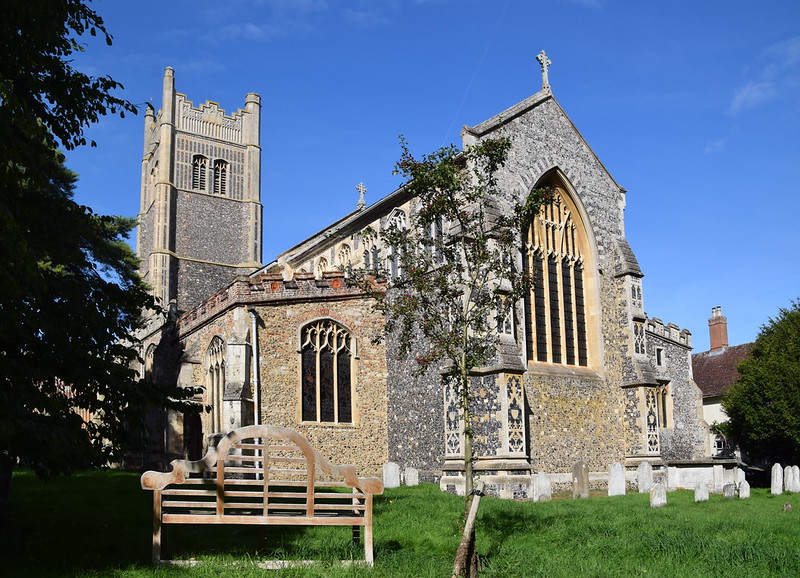
 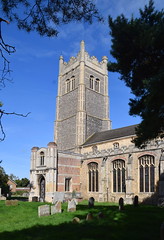 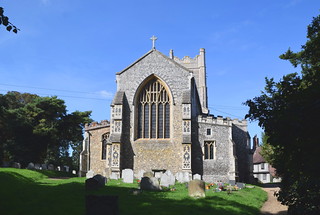
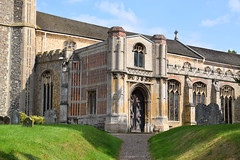 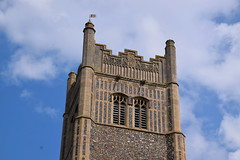 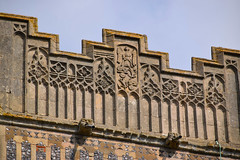
Follow these journeys as they happen at Last Of England
Twitter.
I had not
been back to Eye church for years. I had often passed
through the town, often stopped here indeed, but the
church was such a big project I had usually carried on to
somewhere else. I finally tipped up here on the first
Sunday in September 2018, a few minutes after High Mass
had finished. The great church was full of incense, the
bright summer light thrusting through it, claiming the
interior for something greater and more numinous than
mere congregational worship.
Eye is
perhaps the most robustly independent of Suffolk's
smaller towns. It isn't big at all, but it is far from
anywhere else of any size in the county, if you ignore
Norfolk's Diss looming on the horizon. The railways
reached it, bringing with them proud 19th century
municipal buildings. Until the 1830s, the town returned
two members to parliament, and it still gave its name to
the parliamentary constituency until the 1970s. There is
a castle (or, at least, what looks like a castle), some
decent pubs, a theatre, and one of Suffolk's grandest
churches.
The great flint-encrusted tower of St Peter and St Paul
rises above a memorably crafted interior. Here inside, we
will find the nearest thing Suffolk has to a fulfilment
of the ecclesiological aspirations of our
great-grandparents' generation.
From a tiny spark, a glint in the eye of John Keble at
Oxford in the 1830s, the sacramental revival in the
Church of England spread like wildfire over the course of
the ensuing century. The Church set about rediscovering
its Catholic roots, and the preaching houses of the
Hanoverians were stripped bare and filled with all the
best that the Gothic revival had to offer. In many
medieval churches, original artefacts were rediscovered
and pressed back into service. Where this wasn't
possible, the mass-production workshops of Birmingham and
London could be called upon to provide what history could
not.
Ironically, the catalyst for all this had been some of
those very reform acts which had deprived Eye of its
'rotten borough' status. Catholic emancipation in the
1820s had been followed by grants to a Catholic
university in Ireland. Keble, along with Pusey, Newman,
Froude and the others, saw that the Church of England was
in danger of being sidelined as a protestant sect. The
Oxford Movement, as it became known, published a series
of tracts to try and educate the middle classes about
their lost past. Their intention was that the Church
would recover its catholicity, and its destiny as a
national church, but the inevitable result was that some
of the Movement, Newman among them, would leave the
Church of England to become Catholics themselves.
The medieval Church that they most admired was that of
the early 14th century. This allowed them to see the
later medieval period as a decline, an abuse-riddled
downturn, from which the Church had to be rescued at the
Reformation. However, as the Movement went on, there were
many who asked if the Reformation had really been
necessary at all.
The grandeur of Suffolk's biggest churches on the eve of
the Reformation was a direct result of the county being
the late medieval industrial heartland of England. Here
at Eye that wealth rebuilt the tower in the second half
of the 15th century. The same masons were working at
Laxfield and on the near-identical tower at Redenhall,
over the Norfolk border. As at Redenhall, it was De la
Pole money that rebuilt it, and the family arms are
discernible still. Most spectacularly, high up on the
south side of the tower top stands St Michael the
archangel, overseeing it all.
Sam Mortlock
points out that you can see the shape of the windows
change from late-Decorated to Perpendicular over the
course of the 40 years or so it took to build. You can
see the last windows, the pure rationalism of the late
Perpendicular period, right at the top in the bell-stage.
Beneath are some more mystical Decorated windows, and
below them the vast west window which bridges the gap
between the two.
As the tower was being completed, so the rest of the
church was undergoing an opulent rebuild. You can see
evidence of the extension at the east end of the south
aisle, where a blocked door sits beside the new one into
the chancel. As at Lavenham, the parishioners here were
left in no doubt about the rise of secular power and its
might. Soon, the De la Poles, the Springs, the De Veres
and so on would outgrow the middle ages, and the
aspirations of wealthy families such as these would give
rise to the Reformation, the nation state, and ultimately
capitalism itself.
This was in the future. For now, the De la Poles invested
in prayers as well as commerce, and although their south
porch is a bit battered these days, it remains one of the
loveliest in Suffolk, its brickwork echoing the gildhall
on the other side of the church. You can only enter it
from inside the church if you hope to see the dole table
and fine 13th century doorway that survives of the
earlier church, and you have to be there when it is open,
for it now contains a shop.
Externally then, this is one of the great East Anglian
churches. Here we see the late medieval Church in all its
glory.
But in the 1530s, a collision of expediency and
opportunity put an end to it all. Henry VIII took the
Church out of Europe. His son Edward VI enforced its
protestant credentials, and Edward's sister Elizabeth I
settled the whole thing by imposing the Elizabethan
Settlement, a suppression of the old ways, to bolster her
grip on power. The past was subverted and lost, first as
Anglicans, and then as Puritans, we overthrew the
religion of our parents and grandparents, of the long
English generations. We all but obliterated the old
order, the ancient faith. Much was lost which was dear to
us, and much was forgotten which we had believed to be
true. This was what the Oxford Movement tried to recover,
but in the context of a national established church, with
spectacular results.
By the end of the 19th century, the Anglo-catholic
movement was in the ascendant. Most churches now saw Holy
Communion as the main service rather than Morning Prayer.
Most churches returned their focus to the altar rather
than the pulpit. Perhaps the formality and splendour of
the high church aesthetic chimed with the pomposity and
rhetoric of British imperialism, for it is worth noting
that the rise and fall of Anglo-Catholicism as a
mainstream tradition coincided almost exactly with the
growth and decline of the British Empire. The movement
reached its height in the early years of the 20th
century, and probably the greatest exponent of
Anglo-catholic fixtures and fittings was Ninian Comper.
Comper, who will be familiar to many in Suffolk for his
work at Lound and Kettlebaston, at Ipswich St Mary Elms
and Ufford, all beacons of early 20th century
Anglo-Catholic correctness.
All disappearing now, alas. The ritualist tide has
receded almost completely, and only the trappings and
debris survive here and there, a reminder of what once
was. An age that hovers on the edge of a public memory,
when the formal vision of the established Church was at
the heart of British daily life, an age of candles and
incense, of richly coloured vestments and four-part
choirs. An age of anthems, and war memorials, and
processions, and coronations, and a liturgy that brought
you to your knees.
But in some places some of this still survives. Here at
Eye the tradition has not completely receded.
You walk beneath the great tower with its wonderful
fan-vaulting so uncharacteristic of Suffolk, and then
into the open space of a large, civic church. As at
Hadleigh, Halesworth, and other small Suffolk towns, the
19th century restoration here was pretty significant.
However, into this created space have been placed
furnishings of superb quality and design. The centre
piece is Comper's magnificent rood loft, built on the
remains of the medieval screen in the mid-1920s. The
screen below is perhaps not as good in its way as some of
the county's other late-15th century screens, but in any
case pales slightly beneath the loft, which is easily the
best 20th century work of its kind in Suffolk.
The figures on the dado screen must have been painted in
about 1500, which is to say rather later than most East
Anglian screens. Pevsner thought that they were all
bad. It is true that they are doll-like, with
nothing like the sophistication of those across the A140
at Yaxley, for example, but they have a certain naive
charm. Perhaps they are symptomatic of the decay in
English art towards the end of the medieval period.
Curiously, the gessowork that forms a relief to the
figures is really quite sophisticated. They are, from
north to south: I: St Paul, II: St Helen, III: St Edmund,
IV: St Ursula and her eleven thousand virgins, V: Henry
VI, VI: St Dorothy, VII: St Barbara, VIII: St Agnes, IX:
St Edward the Confessor, (the gap into the chancel is
here), X: St John the Evangelist, XI: St Catherine, XII:
St William of Norwich, XIII: St Lucy, XIV: St Thomas of
Canterbury, and XV: St Agatha.
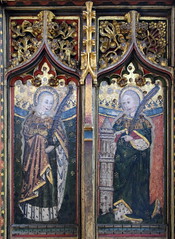  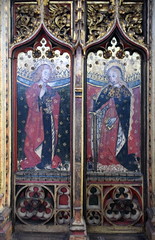  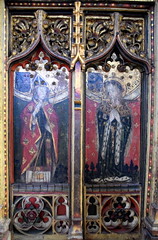
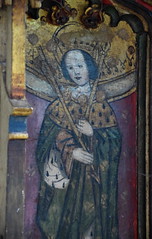 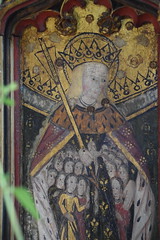 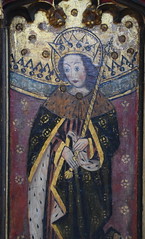 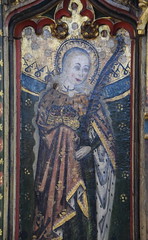
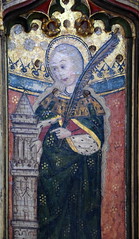 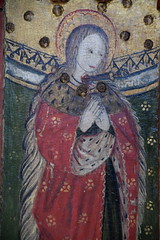 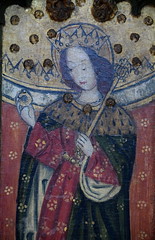 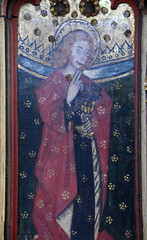
 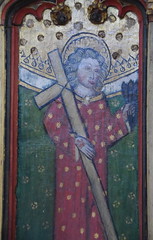 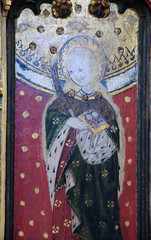 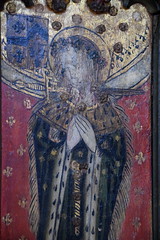
Many of these
Saints had strong local cults in the late medieval
period, and are familiar from other East Anglian screens.
The less common St William of Norwich adds a little
colour, standing as evidence of an anti-semitism that
persisted well into the late middle ages, despite (or
perhaps because of) the fact that the Jewish population
had been expelled some two centuries previously. Two of
the other images resonate strongly - the cults of Henry
VI and St Thomas of Canterbury were particularly frowned
upon by the 16th century reformers.
Up in the chancel, an entirely secular memorial recalls
the Reverend Thomas Wythe, for fifty years Vicar of this
Parish. he died in 1835, and the monument notes that he
cordially believed, zealously preached, assiduously
practiced. It is unlikely that the Reverend Wythe
would recognise the inside of his church today. Much of
what was foregrounded in this church by the considerable
1850s restoration was further adapted and enhanced by the
higher church over the ensuing century. The most
spectacular work is by Ninian Comper. As well as the rood
and rood loft already mentioned, he produced the great
east window depicting the Risen Christ flanked by St
John, St Peter, St Paul and St Polycarp in memory of John
Polycarp Oakey, parish priest here who died in 1926.
    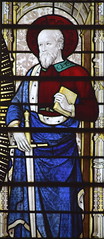 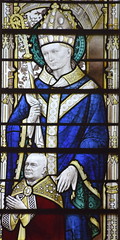 
Oakey oversaw
the Anglo-catholic revival here with the help of Maude
Tacon of Brome Hall, who was patroness of the living and
also, it seems, Oakey's lover. Comper was a close friend
of the Tacon family, and even designed Maude Tacon's
memorial in Eye Cemetery when she died. Comper's also is
the towering font cover, and the window of St George in
the north aisle in memory of George Gerald Warnes, a
'Black-and-Tan' auxiliary who was gunned down by the IRA
in Grafton Street, Dublin during the so-called 'Troubles'
that preceded the Irish Civil War of the 1920s.
The process continues. The elegant tomb recess in the
north aisle, for example, is host to Lough Pendred's
1960s Madonna and child. Pendred carved the same subject
in a different composition for the lady chapel in the
south aisle. To be honest, this kind of light wood
romantic abstraction is very much of its decade, but
there is a poignancy to its presence here in one of the
surviving outposts of modern Anglo-Catholicism. Eye is
one of the few Suffolk churches that still 'sports the
big six'; that is to say, has six tall candles on the
high altar.
Comper decorated the chancel roof, which glows
magnificently in the morning light through the east
window. Tucked away in two corners are two
post-Reformation tombs to Nicholas Cutler and William
Honyng, the first in the north aisle (it was originally
in the sanctuary, according to Mortlock) and the second
in the south aisle chapel. They are curious, because they
appear to be almost identical, although whether this is a
tribute to early-modern vanity or mass-production I
couldn't say.
This is a church in which to wander. It is full of
interest, little details and quiet corners. A bit like
Eye itself. Beside the church, the large, half-timbered
building to the north is the former guildhall. For a long
time this was a wonderful second hand bookshop, but that
is now closed. On the corner post are the restored angels
of the Annunciation - one only has been left unrestored.
Perhaps it can stand as the symbol for this splendidly
reinvented church.
Simon Knott, September 2018
Follow these journeys as they happen at Last Of England
Twitter.
|
|

